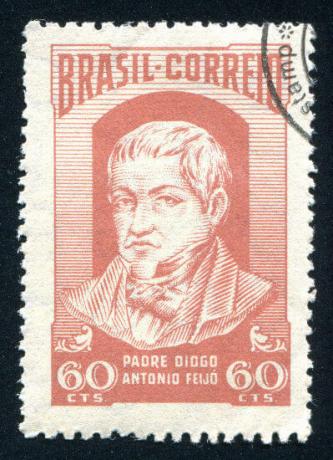O Governing Period is how we know the in-between period that existed between the First it's the second reign. It extended from 1831 to 1840 and was initiated after Emperor D. Pedro I abdicated the throne in favor of his son in the year 1831. It was closed in 1840 with what became known as Coup of Age, which guaranteed the coronation of D. Pedro II as Emperor of Brazil.
Historical context
The Regency Period resulted directly from the way the First Reign ended (a time when Brazil was ruled by D. Peter I). The First Reign was marked by the emperor's authoritarianism and by the growing confrontations between Brazilians and Portuguese. The existing tensions and pressures made the emperor abdicate of the Brazilian throne in April 1831.
When D. Pedro I abdicated the throne, the successor was naturally his son, Pedro de Alcântara. However, the prince of Brazil was only five years old and, by law, could not be crowned emperor of Brazil until he reached the age of majority, which would only be reached when he reached 18 years of age.
Thus, the existing legal exit that was contained in the Constitution of 1824 it was to make a transition period in which the country would be governed by regents. This period should have passed until 1844, when Pedro de Alcântara would turn 18, but its end was brought forward to 1840 by means of a parliamentary coup.
Read too: What is a coup d'etat?
Regency Period Phases
The Regency Period was reasonably short (only nine years). Anyway, throughout this period, Brazil had four different regency, which can be used as dividing marks of the Regency Period. The four periods were:
Provisional Three-fold Regency (1831)
Permanent Triune Regency (1831-1834)
Una Regency of Feijó (1835-1837)
Una Regency of Araújo Lima (1837-1840)
When the Regency Period began, Brazil was governed by a triune regency of a provisional nature. Three senators elected for this regency: Francisco de Lima e Silva, Nicolau Pereira de Campos Vergueiro and José Joaquim Carneiro de Campos. The main measures taken by this provisional regency, as highlighted by historians Lilia Schwarcz and Heloísa Starling, were to restore ministers who had been dismissed by D. Pedro I, to convene a new Legislative Assembly for the composition of new laws, amnesty for political criminals and remove “disorderly” foreigners from the Army|1|.
The Trina Provisional Regency was short-lived, as Brazilian politics were in turmoil and a series of riots spread across the country. Thus, in June 1831, she was elected to Permanent Triune Regency, which was composed of José da Costa Carvalho, João Bráulio Muniz and FranciscoinlimeandSilva.
During the Trina Permanente Regency, there were three outstanding events. One of them was the creation of National guard, a public force composed of male voters aged 21 to 60 years old. This force was created in order to control demonstrations and prevent riots from happening.
Another prominent measure was a reform in the Moderating Power, removing attributions from this power and giving greater possibilities for deputies and senators to inspect the actions of the Executive. Finally, a last notable event was the political clash between José Bonifácio and Father Feijó, which resulted in José Bonifácio's departure from Brazilian political life.

Diogo Antônio Feijó, Father Feijó, was one of the great names in Brazilian politics during the Regency Period.*
The Trina Permanente Regency also lacked the strength to bring the course of national policy under control. Conflicts between Moderates, Exalted and Restorers remained, and revolts sprang up across the country. One of them was the hut, which broke out in 1832, in the province of Pernambuco.
The continuity of tensions in Brazil made it clear that there was a clash between the government and the provinces. The clash involved mainly the issue of centralization of power in the government against the desire of the Brazilian provinces to achieve greater autonomy (federalism). To meet the demands of the provinces and bring the political situation under control, the Additional Act of 1834, a law that made amendments to the 1824 Constitution. With the Additional Act, the most sensitive changes were:
end of moderating power during Regency Period;
end of the Council of State;
creation of Provincial Legislative Assemblies;
increased powers of provincial presidents, but appointment was the function of the emperor;
replacement of the three-way rulership by a single rulership.
With the changes stipulated by the Additional Act, a model was outlined in Brazil that granted the provinces a considerable degree of autonomy. Furthermore, the election of a regent to govern the entire country brought Brazil closer to a republican scenario. Hence, many historians claim that the Regency Period was a republican experience in the middle of two reigns.
With the determination that the country would be governed by only one regent, elections were organized. In an election held in 1835, the Father Feijó he obtained 2826 votes and thus defeated Holanda Cavalcanti, who obtained 2251|2|. The regency of Feijó was marked by Cabanagem, in Pará, and by Revolta dos Farrapos, in Rio Grande do Sul.
Feijó had an explosive humor and faced strong opposition on all fronts of Brazilian politics. This opposition made Father Feijó request removal from office. With his departure, a new election was held, and Pedro de Araújo Lima he defeated Holanda Cavalcanti and was elected regent of Brazil.
During Araújo Lima's regency, there was a growth of conservative politicians (mix of Moderate Liberals with Restorers) and attempts by the regent to try to take away some of the liberties the provinces had won with the Additional Act of 1834.
Policy in the Regency Period
The Regency Period was marked by the intense political movement that took place in the country. The political debate during this period was quite heated and revolved around three political groups, which gradually became the two political parties of the Second Reign. In the case of the Regency Period, the main political groups were:
moderate liberals: in general, they were monarchists who defended the limitation of the emperor's power. They defended a constitutional monarchy in the country and had Father Feijó as their greatest representative.
liberals andxalted: they were open advocates of federalism, that is, of expanding the autonomy of Brazilian provinces. Some of the exalted were defenders of the republic, and the most influential name of this group was Cipriano Barata.
Restorers: were supporters of the return of D. Pedro I to the Brazilian throne and had in the Andrada brothers (José Bonifácio was one of them) their greatest exponents.
During the Regency Period, these groups became the two parties that centralized politics during the Second Reign. O BrokenLiberal emerged from the mix of moderate liberals with the exalted ones, and the BrokenConservative it arose from the mix of moderate liberals and restorers.
revolts
The great mark of the Regency Period were the provincial revolts, which took place in different parts of the country. These revolts involved political dissatisfaction with the direction the country was taking, in addition to local political disputes, popular dissatisfaction with poverty and inequality, etc.
During the Regency Period, the main revolts that took place were:
cabin: rebellion that took place in Grão-Pará between 1835 and 1840 due to popular dissatisfaction with poverty and inequality and due to local political disputes.
Balaiada: rebellion that took place in Maranhão between 1838 and 1841 and was the result of local political disputes.
sabinada: it was a rebellion of a separatist character that wanted to establish a republic in Bahia. It took place between 1837 and 1838.
Malês revolt: it was a slave rebellion that took place in Salvador in 1835.
Revolt of the Farrapos: it was a revolt motivated by the local elite's dissatisfaction with the government for political and economic reasons. It extended from 1835 to 1845.
How did the Regency Period end
The end of the Regency Period was the result of political dispute between liberals and conservatives. Liberals dissatisfied with the regency of Araújo Lima, a conservative, reacted by defending the anticipation of the majority of the prince of Brazil, Pedro de Alcântara. The liberals managed to win the support of the majority of deputies and senators and carry out the Coup of Age in 1840.
With this coup, Pedro de Alcântara reached his early adulthood and became Emperor of Brazil at the age of 14 years. This act started the Second Reign and left the liberals satisfied that power was taken out of the hands of the conservatives. Liberals also hoped that the emperor's coronation would put an end to the series of provincial revolts taking place in the country.
Exercise solved
Throughout the Regency Period, rebellions took place in different parts of Brazil, some short-lived and others longer. Select the alternative that brings a revolt that did NOT take place in the Regency Period.
a) Cabaning
b) Sabinate
c) Hut
d) Praia Revolution
e) Revolt of the Farrapos
LETTER D
The Praieira Revolution took place in Pernambuco between 1848 and 1850, therefore, during the Second Reign. This revolt happened for local political issues, but also for social issues, which involved local dissatisfaction with the weakening of the Pernambuco economy. It is considered a manifestation in Brazil of the liberal ideals that swept Europe during the Revolutions of 1848.
|1| SCHWARCZ, Lilia Moritz and STARLING, Heloisa Murgel. Brazil: a biography. São Paulo: Companhia das Letras, 2015, p. 245.
|2| FAUSTO, Boris. History of Brazil. São Paulo: Edusp, 2013, p. 147.
*Image credits: rook76 and Shutterstock
By Daniel Neves
Graduated in History
Source: Brazil School - https://brasilescola.uol.com.br/historiab/periodo-regencial.htm

